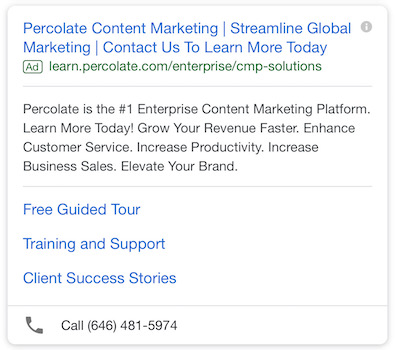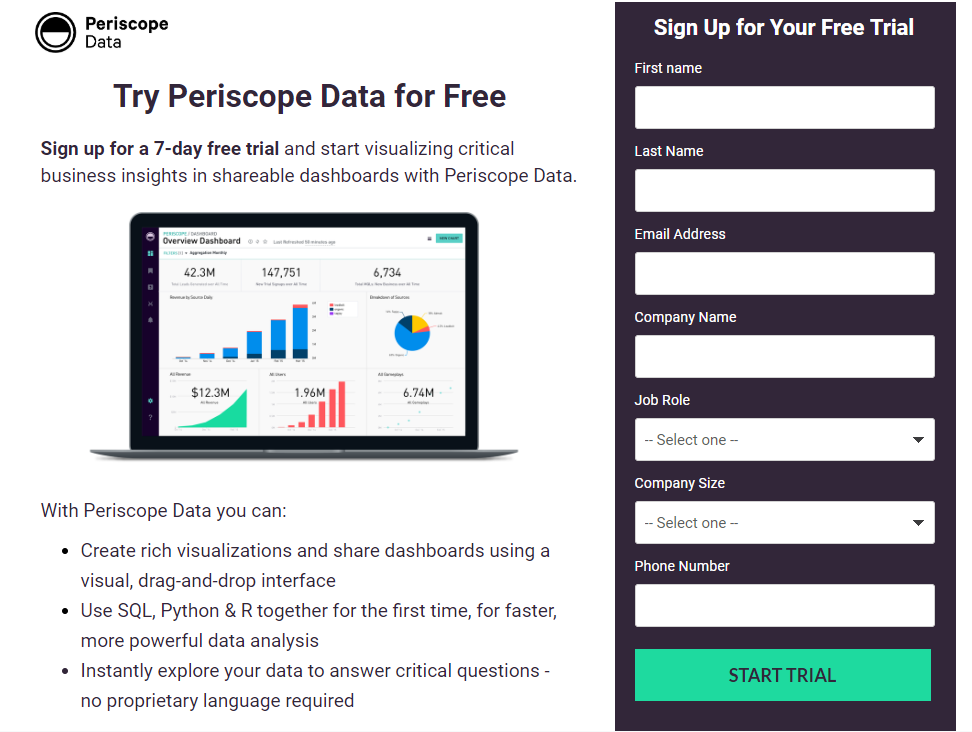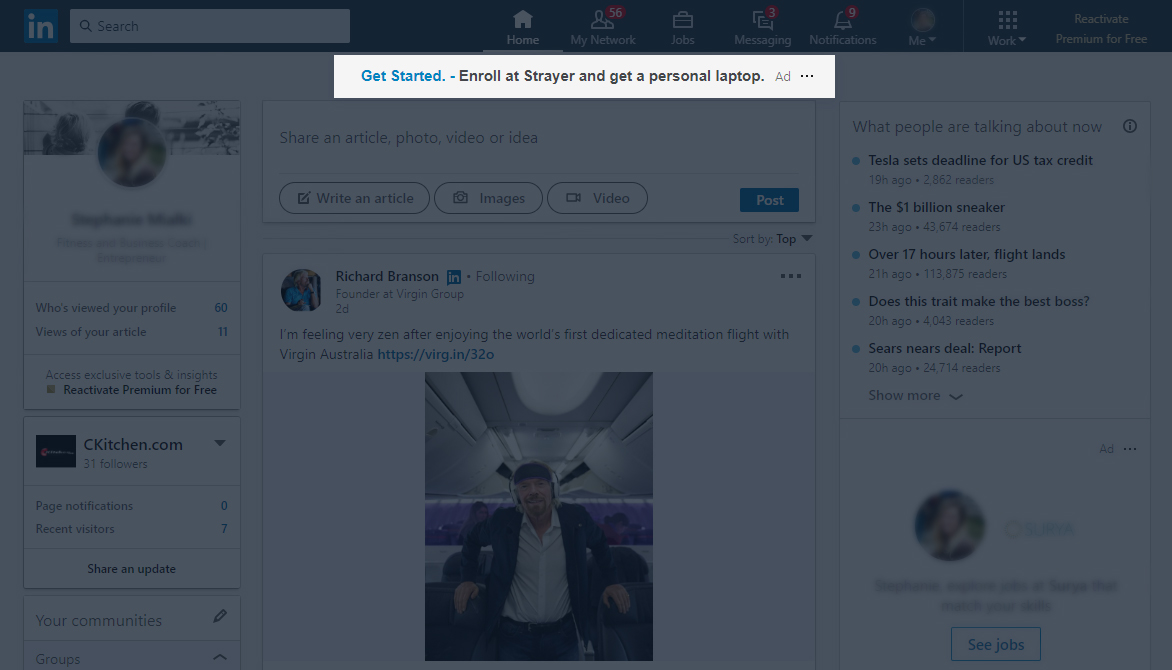Targeted, compelling text ads are essential to a high-performing PPC campaign, as they’re often the first point of contact a prospect has with your brand. People search for something, and your text ad shows up in the results.
The way you craft your ad determines if people click through to your website or post-click landing page, so you better make it relevant and powerful.
Google text ads: An overview
A standard Google Ads text ad is made up of three main elements:
1. Headline
There are two required headline fields, and one optional, each with a 30 character limit. All headlines appear next to each other, separated by a vertical pipe (“|”), like this:

The headline may wrap to a second line, depending on the size of the user’s screen. For instance, this is a wrapped headline on a mobile screen:

2. Description
Google Ads allows two 90-character description fields, giving advertisers plenty of control over their ad’s messaging. Scorpion takes full advantage of both description fields in this example:

3. Display URL
The domain of your final URL is shown as your ad’s display URL. Display URLs are not active links, but they give search users an idea of where they’ll end after clicking the ad.
Below, the green “www.writingclasses.com/” next to the Ad indicator is the display URL, even though the final URL is https://www.writingclasses.com/classes/index:

Those are the basics but to create your most successful text ad, consider several of these best practices.
What makes a successful Google text ad?
Path fields in your display URL
Not only do path fields give prospects a better idea where they’ll end up, but the fields can also help increase your click-through rate because you can message match the keywords to their search query. Google offers advertisers up to two optional ”path” fields to the display URL. Each path can have up to 15 characters and is added to the display URL immediately following your website’s domain.
In this example, “www.marketing360.com/” is the domain, while “Doctor” and “Marketing” are the two path fields:

Note: Path fields don’t have to be part of your page’s URL, but they should at least be related to your post-click landing page’s content.
Compelling ad copy
When writing text ad copy, keep these five main components in mind:
- Promise — Make an aspirational promise to viewers how your product benefits them
- Value — Without using aggressive sales language, highlight what makes you unique: Free shipping? Award winning? Customization? Special promotions and exclusives?
- CTA — Directly tell viewers to do something specific, such as purchase, order, browse, download, call, sign up, get a quote, etc.
- Keyword — Include the keyword at least once (preferably in one of the headlines), to show your ad’s relevance to the search query
- Brand — Include your brand name to potentially increase CTR
Ad extensions
True or false: Adding an extension to a text ad improves an advertiser’s Quality Score.
True.
Sitelink extensions, in particular, have shown to lift Quality Score by 8%, which in turn, can increase ad exposure and decrease cost-per-click. Ad extensions also typically increase CTR by several percentage points because they show prospects more information and extra incentive to choose your business.
Extension formats include:
- Sitelink and dynamic sitelink
- Location and automated location
- Affiliate location
- Call and automated call
- Message and automated message
- App
- Callout and dynamic callout
- Structured snippet and dynamic structured snippet
- Price
- Promotion
- Seller ratings
Google Ads selects which extensions to show in response to each individual Google search. Therefore, it’s a good idea to use all extensions that are relevant to your business goals — especially since it doesn’t cost extra.
However, whether or not Google Ads shows your extensions depends on:
- Ad Rank — A combination of your bid, the quality of your ad and post-click landing page, Ad Rank thresholds, the context of the search, and the expected impact of extensions and other ad formats
- Ad position — Ads in higher positions on the search results page get the first opportunity to show extensions, and ads in lower positions won’t have more extensions than ads in higher positions (to show ads in higher positions, you must increase your ad quality, bid, or both)
- Your other enabled extensions — In each auction, Google generally displays your highest performing and most useful combination of eligible extensions and formats
Mobile-optimization
All devices use expanded text ads, so there isn’t a device preference setting. However, a preview of your ad in both desktop and mobile format is generated during ad creation, so it’s your responsibility to optimize for both. This includes adding the appropriate extensions for each format.
For example, this same Percolate ad appears slightly different on desktop and mobile because the company optimized it accordingly. Notice how it only has sitelink extensions on desktop:

But it also has a call extension on mobile:

A dedicated post-click landing page
Sending prospects to a post-click landing page after clicking your ad is critical because that’s where the conversion happens. Be sure to follow post-click landing page best practices — including message match — to decrease bounce rates and increase conversion rates.
See how well Periscope Data’s post-click landing page matches their ad:


Some variation of “7-day free trial” is mentioned several times in both places: the ad headline, post-click landing page headline, post-click landing page copy, and lead capture form. People seeing this page have no doubts they are in the right place after clicking the ad.
A/B testing
As with any ad campaign, be sure to test variations to see which one performs the best. Create three to four variations for each ad group, with different messages, CTAs, etc. Google Ads will automatically rotate your ads to show the best-performing ads more often.
What other platforms support text ads?
Image-based platforms like Instagram, and even Facebook, don’t support text ads because text alone isn’t likely to stop users’ scrolling. With image ads, though, it’s still important to consider text. Facebook ad text includes text on top of a photo or illustration, text-based logos, watermarks used in an ad’s image, and text in thumbnail images used for videos. Their platform prefers image ads with less than 20% text, because any more than this may create a lower-quality user experience and even reduced impressions.
As far as platforms that do support text ads, look at Bing and LinkedIn.
Bing text ads
Bing text ads are similar to Google in that they are a mobile-optimized search ad format that enables advertisers to craft longer, more engaging ad copy. They also allow similar ad extensions, like this desktop ad with sitelink extensions:

And this mobile ad with price extensions:

Bing has specific word count and character limits:
- Minimum word count — Combined total of at least 3 words in title and descriptive text
- Title — Two 30-character ad titles separated by a hyphen (the two titles combined must be less than 77 if dynamic text is used)
- Descriptive text — 80 characters, including spaces (300 if dynamic text used)
- Paths — Two customizable URL paths, with 15 characters each (50 if dynamic text used)
- Display URL — Domain and subdomain automatically generated from your final URL
- Final URL — 2048 characters
- Mobile URL — 2048 characters
- Tracking template — 2048 characters
- Custom parameter name — 16 characters
- Custom parameter value — 200 characters
But best practices for Bing text ads are similar to those of Google.
LinkedIn text ads
LinkedIn text ads show on the top or to the right of the feed on the homepage, profile pages, group pages, messaging page, My Network page, Who’s Viewed My Profile page, and search results page. They only appear on desktop:

Headlines have a 25-character limit, and descriptions have a 75-character limit, but the entire ad can be a variety of sizes:
- 300×250
- 17×700
- 160×600
- 728×90
- 496×80
Best practices are similar to Google and Bing:
- Be direct and stand out — Speak to your audience directly, use attention-grabbing headlines, and add strong CTAs
- Link to a post-click landing page — Be sure it matches the message of your ad and optimize it for mobile
- Always be testing — Use A/B testing to see which version of your ad resonates best with your target audience
Earn the click with text ads and more
To ensure prospects click through, you need to create targeted, compelling text ads. Part of creating the best ad is knowing the specs for each ad format. While this sounds overwhelming, it doesn’t have to be.
The Instapage digital advertising reference guide contains all of the dimensions, file formats, and sizes — everything you need to know to create compelling ads across all devices. Claim your copy today and build better text ads faster.
